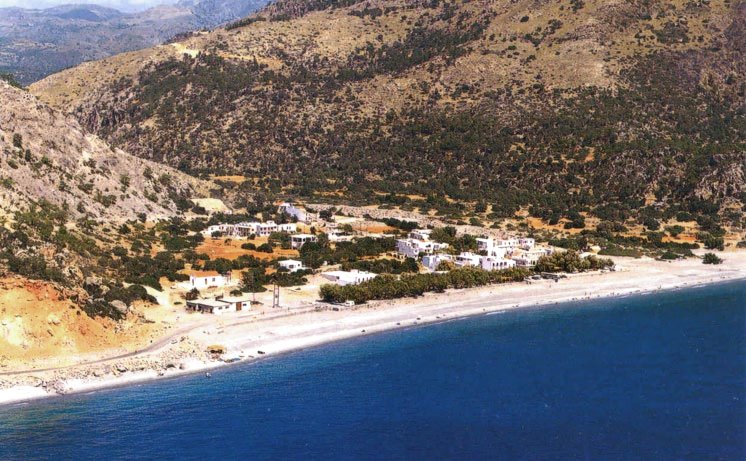
Sougia or Souyia (GR: Σούγια) is a small coastal village, located on the south shores of Hania prefecture a little to the east from the town of
Paleohora.
It was the site of the ancient town
Syia that flourished during the Roman times. In modern times Sougia became a village after the second world war and late years it started to develop into a seaside tourist resort, not only due to its gorgeous beach and natural beauty but also for the peaceful and relaxed atmosphere that Sougia offers to its visitors.
The village has approximately 110 inhabitants and is part of the Sougia community which comprises three more little villages( Koustogerako 174 , at 510m a.s.l. Livadas 87, at 300m a.s.l. and Moni 92, at 162m a.s.l).
The driving distance from the town of
Hania is approximately 75 kilometers via Tavronitis and Kandanos. Sougia can be reached also from the plateau of
Omalos.
The beach
One of the major attractions of Sougia is its one kilometer long, pebble beach, that stretches from east to the west, with a width that in some points reaches 70 meters. The pebbles are from coarse to very fine with nice colours.
The sea is one of the cleanest in all Greece and quite safe, with no currents, although in some points it deepens abruptly.
During the summer season the prevalent westerly winds, some times, may get strong and unpleasant.
Umbrellas and sun beds are provided only in limited areas.
Nudism is tolerated at the east side of the beach, which for that reason is called "Matala" by the locals, reminding the village of Matala in the 60's.
Facilities
Accommodation is available mostly in self catering apartments / studios and in one small hotel.
There are plenty of taverns and restaurants with good food and friendly prices some of them on the beach front.
There are also quite a few café - bars and a couple of Internet cafés but very limited options for nightlife.
A few shops and mini markets sell foodstuff, items of general use, books, beach equipment, phone cards etc.
There are no banks but there is an ATM.
A small harbour, located at the west end of the coast, offers shelter to small boats.
Access
There is regular public transport to Sougia once or twice a day (depending on season and week day) from and to Hania. The last bus to Hania departs after the arrival of the boat from Agia Roumeli. The journey takes about two hours. You can see the schedules and prices
here.
Taxi is a good option for those who come to Sougia. If you need a taxi out of Sougia, make sure that you book it in advance, as there are only two taxis based in Sougia and they may be busy.
What to do
Many people come to Sougia in order to have a quiet time and enjoy its beautiful beach. For the more active there are a fair number of things to do.
A walk to nearby Lissos is almost a must. Lissos was a very significant town in ancient times and there are still many ruins left, particularly an Asclepius 's sanctuary (Asklepieion).
The walk to Lissos and back takes about 3 hours at a leisurely pace. The atmosphere in Lissos is so peaceful that it is well worth spending time there, wandering around the ruins and enjoying the silence, broken only by the sound of sheep bells.
Walking down through the gorge of Agia Irini is also a very nice walk. The walk starts from the village of Agia Irini, a few kilometers to the north of Sougia at around 560m above sea level. The walk through the gorge is 7.5km but there is another 7kms walk, following the road, to reach Sougia. You can take a taxi or the early morning bus to get to Agia Irini.
Another beautiful walk follows the coast towards the East to the chapel of the Prophet Elias. As it takes about 4 hours to get there it is a good idea to hire a boat one way and return on foot.
If you have a car you can drive up to the ancient city of Elyros (situated close to the village Rodovani). It is located on a hill overlooking the sea and the mountains and there are plenty of ruins to see (although only a few have been excavated). Driving west you can also get to Paleohora if you feel like visiting a more lively village.
There is also a boat going to Paleochora and the island of Elafonisi on Wednesday. It leaves Sougia at 9.00 and returns from Elafonisos at 16.00, arriving back in Sougia at 17.45. Tickets can be purchased locally.
You can also take a public bus (or a taxi) in the morning to Omalos and walk through the famous Samaria Gorge. For the less fit, an alternative is to take the ferryboat to Agia Roumeli and walk a part of the Samaria gorge from the bottom up, returning in time for the afternoon ferry which returns to Sougia.
History
Syia in ancient times was one of the harbours of the city of Elyros and part of the Confederation of Oreii, an accord formed around 300 BC between Elyros, Lissos, Irtakina, Tarra, Syia and Pikilassos. They were later joined in the Confederation by Gortys and Cyrenaica (in North Africa).
Syia flourished in the Roman Period and the first Christian Years.
The largest part of the ancient city was in the eastern side of the valley where ruins of Roman houses, baths, tombs as well as the remains of an aqueduct can be seen. There are also the ruins of two early Byzantine basilicas with interesting mosaics that were destroyed by the Saracens. A third one dedicated to Agios Panteleimon was found within the modern village. It was a three-aisled church with mosaics with geometric patterns and wild animals and birds. This church was rebuilt after the second world war.